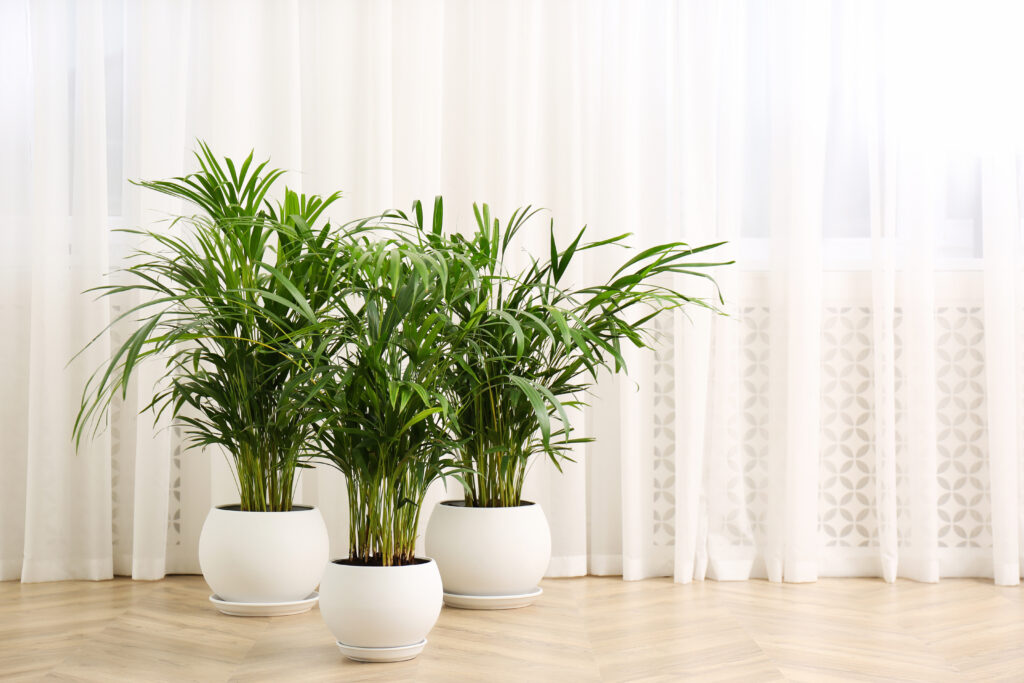Due to its stunning look and simplicity of care, the areca palm tree is undoubtedly one of the most beloved palms in tropical and subtropical regions. Fans of this palm tree can grow it either inside or outside, making it a very versatile plant.
Let’s explore some more interesting facts about the areca palm tree, as well as some advice on how to grow your very own.
What are Areca Palm Trees?
The areca palm tree, also known as the butterfly palm or golden cane palm, has quite a few botanical classifications. It can be classified as Chrysalidocarpus lutescens (which is an outdated name), Dypsis lutescens, or Areca lutescens. This palm is native to the Madagascar islands, though it can be found naturalized around the world.
The smooth, silver-green trunks of the areca palm are topped with arched, feather-like fronds. It forms dense bunches of many stems as it develops in groups. Usually, there are six to eight bent-upward yellow-green leaves on long petioles, giving the plant a butterfly-like appearance. This is why the areca palm is also sometimes called the butterfly palm. It has up to seven-foot-long pinnate-style leaves. The 90 to 110 leaflets on each leaf are arranged in a V-shaped pattern. Mature areca palms have cane-like, ringed trunks that somewhat resemble bamboo palms. Because of its golden petioles, the areca palm is also known as the golden cane palm.
The areca palm has a modest growth rate and will reach a height of 20 feet with ease when grown outdoors. It will grow in width before it will grow upwards in height. The areca palm blooms in late spring or early summer, when tiny and bright yellow flowers appear underneath its leaves. In the same inflorescence, it has both male and female flowers. Flowers bloom for a few months, then die away to show light green to yellow fruits, which become yellow-orange or red when they ripen. Fruits of this plant are oval-shaped and have a diameter of around one inch. While they appear very tasty-looking, they are unfortunately inedible.

Areca palm fruits (pictured) are not edible but are a good sign that one’s palm is growing properly.
©iStock.com/chaikom
How to Care for an Areca Palm
Growing an areca palm indoors is quite easy. It can also be grown outdoors, but only in USDA hardiness zones 10 through 11. While growing these plants outside, it’s crucial to pick a planting location with sufficient drainage. Root rot on a palm is readily brought on by wet soil and can cause a swift death. A well-draining container is necessary for growing these plants inside as houseplants.
Plan to water your areca palm regularly anytime the soil begins to dry out. It’s crucial to keep outside palms moisturized during hot, dry weather conditions in order to maintain their health. Unless they are situated close to a very bright window, indoor palms often don’t receive enough light. Hence, taking your areca palm outside in warm weather to receive some diffused sunshine might be beneficial. Feed palms both inside and outside all throughout the growing season. These palms do not require regular prunning. Any withering fronds should be left until they are mostly brown since they can still contribute to photosynthesis.
Like many other palm species, the areca palm tree likes to have wet soil, but they are sensitive to overwatering and cannot handle potting soil that is saturated with water. To prevent potential root rot, in between waterings, allow the soil to effectively dry out a bit. Use filtered or distilled water to water this species, as areca palms cannot handle fluoride in their water. You don’t want to accidentally poison your plant!
A high humidity level is necessary to maintain an areca palm’s luscious appearance. The plant will adjust to average indoor humidity levels. That being said, it is very common for this plant’s leaf tips to become brown if the air is excessively dry. We recommend a humidity level of 40% to 60%.
This lovely palm thrives in a temperature range of 65 to 75 degrees F whether it is planted indoors or outdoors. It will do well in areas where the outside temperature doesn’t go below roughly 50 degrees F during any season. Keep indoor plants away from heat sources, air conditioners, and drafty windows when growing them inside. Aside from that, if you keep a potted areca palm tree outside in the summer, make sure to bring them inside before it gets colder than 50 degrees F. The leaves can get black patches as a result of sudden cold bursts, as this is not a cold hardy plant.
These beautiful plants can handle full sun when grown outdoors, but they do prefer bright, somewhat filtered, and indirect light. The areca palm tree does very well indoors with exposure to strong sunlight from a south or west-facing window. Just ensure that no matter where your areca palm is placed that it receives indirect sunlight rather than harsh, direct sunlight.
A well-draining, peat-based potting mix is ideal for indoor potted areca palm plants. The ideal soil for outdoor specimens is rich, somewhat acidic, and has excellent drainage. You can easily amend your soil with sand and peat moss to increase soil porosity and reduce the overall pH of the soil. As the areca palm consumes a lot of food, treating it with a liquid fertilizer from spring through early fall is necessary, whether it is outside or inside. While the plant is dormant in the late fall and winter, do not feed it, as this can cause soil pH balance issues.

Areca palms (pictured) make excellent outdoor and indoor plants.
©iStock.com/Liudmila Chernetska
How to Grow an Areca Palm
The areca palm tree is grown from seed. Although viable areca palm seeds are difficult to find at garden centers or nurseries, you can get them from the fruits that develop after the yellow flowers have bloomed. If you can find an areca plant at the right time to harvest these fruits, then you can grow your own palm for free.
If you’re propagating using seeds, place the seeds in a seed-starting mixture with a thin layer of soil on top to germinate them at home. In general, the older, orange-colored seeds germinate faster and more successfully than the newer, greener seeds. At a temperature of around 80 degrees F and a fairly high humidity level, the germination process of areca palm seeds takes around six weeks.
As you wait for germination, keep the seed-starting mix wet but not soggy. Once germination occurs, keep the new seedlings damp as well. Plant the seedlings outside at a distance of 15 feet from the nearest building after they have a few leaves. Or, for a fuller appearance, place three to five seedlings in a large container that is at least a foot in diameter to grow indoors.
How to Propagate an Areca Palm
If you don’t want to grow these plants from seed and happen to have a mature areca palm on hand, you can make more plants via propagation. Cuttings will not successfully replicate an areca palm, unfortunately. However, root division will result in a gorgeous plant that can grow more quickly than from seed. Although root division can be done at any time of the year, springtime is when the plant is at its healthiest and is an excellent time to propagate. To split an areca palm in a pot through root division, simply follow a few easy steps.
To start, choose an established plant with several stalks. The day before splitting, water your palm thoroughly to break up the dirt around the roots. By tapping the pot’s sides to loosen the root ball, you can remove the palm from it without damaging it. Gently rake the soil away from the roots. If you are struggling to see the roots that correspond to each stem, rinse the soil away from the roots as gently as possible. With a sharp (and well-sanitized) knife, separate four to five stems from the parent.
In a pot with a combination of two parts regular potting soil and one part sand, plant the separated palm stems. Keep the soil wet but not waterlogged and place the container in bright and indirect light. It is crucial to avoid direct sunlight while the new plants are establishing themselves.
Pests and Diseases to Watch Out For
Pests and illnesses don’t pose a significant threat to areca palms. Lethal yellowing, an insect-transmitted bacterial illness that kills fronds and eventually the entire palm, can occasionally infect a vulnerable areca palm. This disease is more prone to affect outdoor palms, and as treatment is usually (and unfortunately) ineffective, it is often recommended to remove and destroy the palm before the illness spreads to other plants.
An areca palm tree grown indoors are susceptible to typical houseplant pests such mites, aphids, mealybugs, and scale, which can harm and discolor the plant’s leaves. Infestations should be treated as soon as feasible with neem oil or insecticide.
Although the areca palm is usually easy to care for, both indoor and outdoor areca palms are susceptible to the same common problem: leaf tip burn. Leaf tip burn is the yellowing or browning of the leaf tips and fronds of the areca palm. This can be brought on by cold air, excessive or insufficient water, nutrient-deficient soil, and root problems.

Spider mites (pictured) can cause a lot of damage to palm species, especially the areca palm.
©Tomasz Klejdsz/Shutterstock.com
Should I Repot My Areca Palm?
Areca palms enjoy being slightly rootbound in a pot with lots of drainage, and dense roots will help keep the palm’s growth under control for growing as a houseplant. To update the potting mix and get rid of salt deposits from fertilizer that have accumulated in the container, it’s still wise to repot the plant every two years or so. You really don’t have to repot this species more often than that. The palm should be replanted at the same depth as the first pot, but try to size up the pot a few inches when repotting.
What are Areca Palms Used For?
While excellent houseplants, areca palms are mostly used for landscaping. Areca palms can be utilized as privacy screens or hedges, to cover vacant walls on the sides of buildings, and as a corner accent plant. They do well in pool cages as well. Areca palms are popular for both residential and commercial landscaping use.
Whether you want to keep this palm tree as a houseplant or as a key feature of your landscaping project, the areca palm is an excellent plant to choose from. If you can give it the ongoing care it needs to stay healthy and pretty, this is definitely a great plant to add to your collection!
Thank you for reading! Have some feedback for us? Contact the AZ Animals editorial team.








